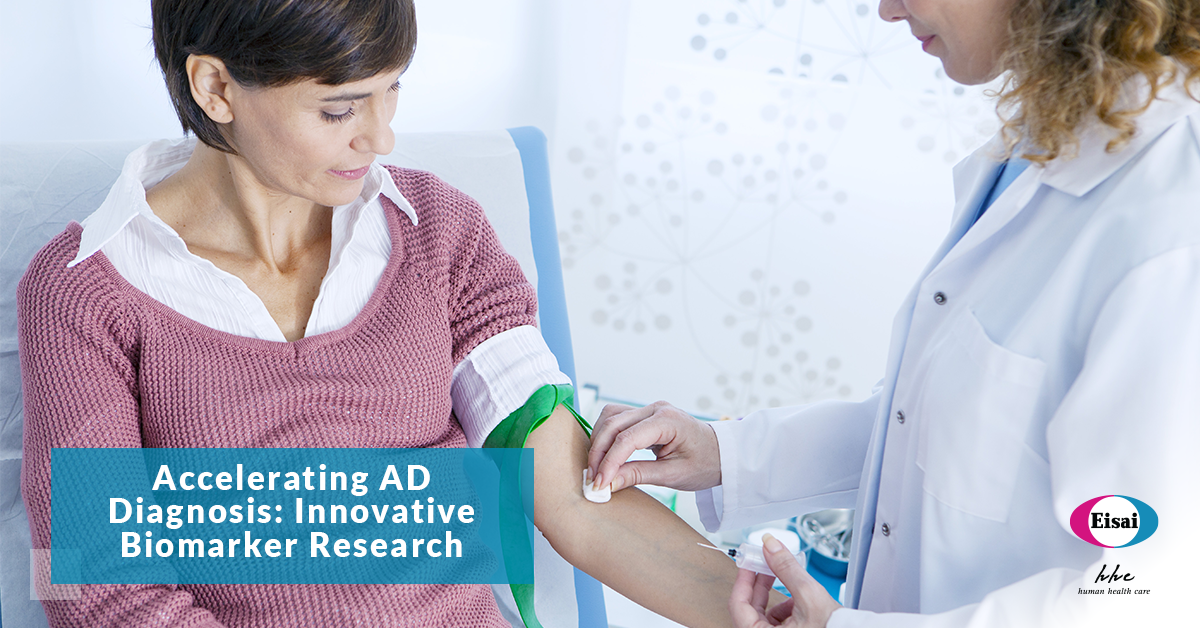
“Imagine diagnosing AD with a simple blood test. While this is not possible today, it is a goal we aspire to for the future.” - Dr. Michael Irizarry, Senior Vice President, Clinical Research, Neurology, Deputy Chief Clinical Officer, Clinical Evidence Generation (CEG), Deep Human Biology Learning (DHBL) at Eisai Inc.
With nearly seven million people in the United States living with Alzheimer’s dementia and the annual number of new cases of Alzheimer’s and other dementias projected to double by 2050, the need for new solutions has become paramount.1
Recent advancements have spurred innovative treatments that can slow disease progression in the earliest stages of the disease before symptoms become severe, including mild cognitive impairment (MCI) due to AD. But currently, only a fraction of patients are diagnosed in time to benefit.1
Eisai is pioneering research by exploring biomarkers that can detect AD early and monitor disease progression.
The Challenge of Early Diagnosis
Early diagnosis of AD is critical for effective treatment and management.1 However, diagnostic frameworks have historically been based on clinical symptoms unsuitable for multifactorial and chronic diseases like AD, in which early stages can start long before symptoms appear.2 Traditional diagnostic techniques, such as lumbar punctures, are often met with resistance from patients due to the perceived invasiveness of the procedure.3 While many patients have benefitted from the increasing availability of amyloid imaging using positron emission tomography (PET), this method, along with the use of plasma in cerebrospinal fluid (CSF), places a significant burden on patients in terms of access, costs, and physical well-being.4
“At Eisai, we plan to support the development of diagnostic tools that can detect Alzheimer’s disease before significant brain damage occurs, by identifying the disease early, there is the opportunity for counseling and therapy, including treatments that can slow the decline of the disease for appropriate patients.”

Dr. Michael Irizarry, MD, MPH,
Senior Vice President of Clinical Research and Deputy Chief Clinical Officer, Neurology, Eisai
Utilizing Biomarkers to Improve Alzheimer’s Diagnosis
To address challenges in early AD diagnosis and intervention, the focus has shifted to the advancement of innovative biomarkers, which can indicate the presence or absence of a disease, as well as the risk of developing a disease.1 These biomarkers are often detectable long before patients show symptoms, creating opportunities to prevent or delay symptom onset.1
Over the last three decades, significant progress has been made in validating fluid and neuroimaging biomarkers that chart AD pathophysiological alterations.5 Biomarkers such as tau have been instrumental in this progress. Blood-based biomarkers are also particularly promising for large-scale, minimally invasive screening, enabling early diagnosis and treatment.6
Leveraging the research being done in the lab, Eisai recently partnered with Sysmex Corporation to advance the development of blood-based assays to detect potential biomarkers. This collaboration aims to create accessible, easy-to-use tests that can support large-scale screening for AD brain changes and potentially improve outcomes for patients and their families. Eisai has also partnered with C2N Diagnostics to expand the availability, accessibility, affordability and utilization of blood-based tests for the diagnosis of AD in the U.S.
“Our goal at Eisai is to transform the entire Alzheimer’s disease treatment paradigm through innovative research and development,” said Dr. Irizarry. “We're excited about the potential for blood-based biomarkers to contribute to early diagnosis, treatment selection and monitoring of treatment effect in AD.”
In addition to these efforts, Eisai's research includes a new model that demonstrates the relationship of treatment to amyloid PET and clinical outcomes, supporting ongoing treatment and the opportunity for less frequent IV maintenance dosing. Further, imaging insights from tau PET data and the novel CSF tangle specific biomarker MTBR-tau243 provide a detailed picture of how the disease progresses and treatment impact on neurofibrillary tangles. Previously reported simulations from Quantitative Systems Pharmacology (QSP) models also highlight the long-term benefits of continuous treatment.
A Brighter Future for AD Diagnosis and Treatment
Eisai's relentless pursuit of innovation in biomarker research in AD is paving the way for a new era in diagnosis and treatment. By focusing on early detection, there is an opportunity to not only advance the scientific understanding of AD but also offer hope to millions of patients and their families worldwide.
“Every step we take in biomarker research brings us closer to a future where early AD can be diagnosed quicker, cheaper and on a larger scale,” said Dr. Irizarry. “Our mission at Eisai is to see to it that this future comes as quickly as possible, knowing how much is at stake with millions of patients and families across the globe and counting.”
To learn more about advances in blood-based biomarkers, amyloid PET, tau PET, structural imaging in AD, and much more, visit www.understandingalzheimersdisease.com/biomarkers-in-ad.
References
- Alzheimer’s Association. 2024 Alzheimer’s Disease Facts and Figures. Alzheimers Dement 2024;20(5).
- Jack, C. R., Jr. et al. Introduction to the recommendations from the National Institute on Aging-Alzheimer's Association workgroups on diagnostic guidelines for Alzheimer's disease. Alzheimers Dement 7, 257-262, doi:10.1016/j.jalz.2011.03.004 (2011).
- Hampel H, Shaw LM, Aisen P, et al. State-of-the-art of lumbar puncture and its place in the journey of patients with Alzheimer's disease. Alzheimers Dement. 2022;18(1):159-177. doi:10.1002/alz.12372.
- Eisai Inc. Sysmex presents academic report with a view to creating a simple method of diagnosing alzheimer’s disease using blood: News release:2019. https://www.eisai.com/news/2019/news201990.html
- Jack, C. R., Jr. et al. NIA-AA Research Framework: Toward a biological definition of Alzheimer's disease. Alzheimers Dement 14, 535-562, doi:10.1016/j.jalz.2018.02.018 (2018).
- Mantellatto Grigoli, M., Pelegrini, L. N. C., Whelan, R., & Cominetti, M. R. (2024). Present and Future of Blood-Based Biomarkers of Alzheimer's Disease: Beyond the Classics. Brain research, 1830, 148812. https://doi.org/10.1016/j.brainres.2024.148812
US4597 © Eisai Inc. July 2024
This article was written by Eisai.





